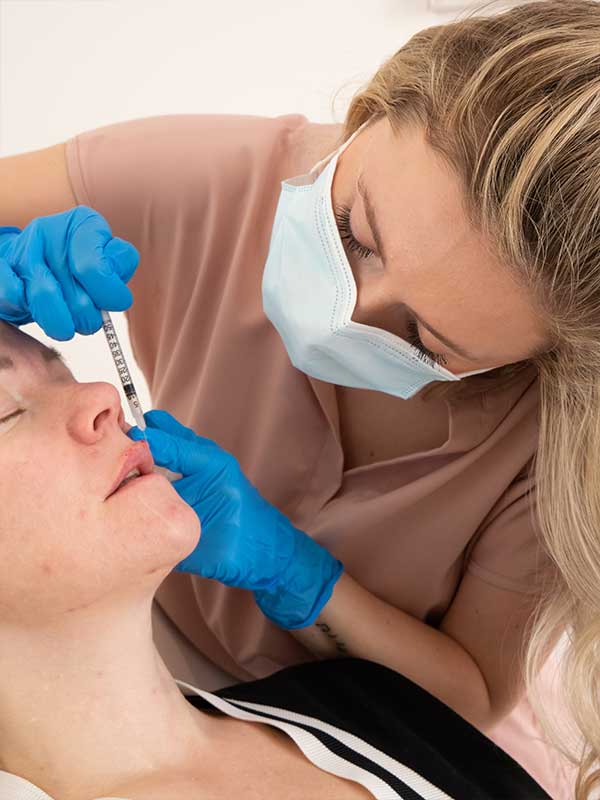
Dermal Filler Treatment
Dermal filler treatments involve injecting a gel-like substance, usually made of hyaluronic acid or other biocompatible materials, into specific areas of the face.
These treatments help restore lost volume, smooth out wrinkles and lines, and enhance facial contours such as the lips, cheeks, or jawline.
Dermal fillers provide immediate, natural-looking results with minimal downtime, making them a popular choice for non-surgical facial rejuvenation.
Why Choose Dermal Fillers?
Choosing dermal fillers can be a great option for enhancing your natural beauty and addressing specific concerns.
Dermal fillers are used to add volume, smooth out wrinkles, and contour areas like the cheeks, lips, and jawline. They provide immediate results with minimal downtime and are reversible in some cases. If you’re looking for a non-surgical way to restore a more youthful appearance, boost facial contours, or improve skin volume, dermal fillers are an effective and versatile choice.
Treatment Time
1 hour
Type
Around 30-60 minutes depending on the area being treated
Prices
Vary depending on area and amount of filler
Anaesthetic
Topical available
FAQ’s
Are dermal fillers safe?
When administered by a qualified and experienced professional like Nurse Kelsey, dermal fillers are generally safe.
They are made from biocompatible materials, such as hyaluronic acid, and have been used safely for many years. However, as with any medical procedure, there are potential risks and side effects, such as swelling, bruising, or mild discomfort, which are usually temporary. It’s important to have a thorough consultation with Nurse Kelsey to discuss your medical history and ensure the treatment is suitable for you. Proper technique and aftercare help ensure a safe and satisfying experience.
Are dermal fillers permanent?
No, most dermal fillers are not permanent. They are typically made of hyaluronic acid or other temporary substances that gradually be absorbed by your body over time.
Depending on the type of filler and the area treated, results can last anywhere from 6 months to 2 years. To maintain your desired results, periodic touch-up treatments are usually recommended. Consult with Nurse Kelsey to determine the best option for your goals and to discuss maintenance.
Are dermal fillers the same as botox?
No, dermal fillers and Botox are not the same; they are different treatments used for different purposes.
Dermal fillers are gel-like substances, often made of hyaluronic acid, that add volume, smooth out wrinkles, and contour the face. They are used to fill lines, enhance lips, and restore lost facial volume.
Botox (botulinum toxin) is a neurotoxin that temporarily relaxes the muscles responsible for wrinkles and lines, especially dynamic wrinkles like frown lines, crow’s feet, and forehead lines.
Both treatments can be combined for comprehensive facial rejuvenation, but they work in different ways. Consulting with Nurse Kelsey can help determine which treatment is best for your specific concerns.
Are dermal fillers safer than botox?
Both dermal fillers and Botox are generally safe when administered by a qualified and experienced professional like Nurse Kelsey. They are different treatments with different safety profiles:
- Dermal fillers are used to add volume and fill wrinkles. Possible side effects include swelling, bruising, or mild discomfort, which usually resolve quickly.
- Botox works by relaxing muscles to reduce the appearance of dynamic wrinkles. Common side effects can include temporary bruising, headaches, or drooping eyelids if injected improperly.
Neither treatment is inherently safer than the other; their safety depends on proper technique, correct dosing, and individual health. It’s important to have a thorough consultation to discuss your medical history and goals. Nurse Kelsey can help determine the most suitable and safe option for you.
Are dermal fillers halal?
Whether dermal fillers are considered halal depends on their ingredients and how they are sourced. Generally, hyaluronic acid-based fillers are derived from a natural substance found in the body and are widely considered halal. However, some fillers may contain animal-derived ingredients or other substances that may not meet halal standards.
It is important to consult with Nurse Kelsey about the specific product being used to ensure it aligns with your dietary and religious beliefs.
Can dermal fillers be removed?
Yes, dermal fillers can be removed or their effects reduced, but the approach depends on the type of filler used.
Hyaluronic Acid Fillers: These are reversible because they can be dissolved using an enzyme called hyaluronidase. If someone is unhappy with the results or experiences complications, a practitioner can inject hyaluronidase to break down and remove the filler relatively quickly.
Non-Hyaluronic Acid Fillers: These are more challenging to remove because they are not naturally degradable with hyaluronidase. Removal may involve surgical procedures or other techniques, which are more invasive and less predictable.
For personalised advice and safe removal options, it’s best to consult with Nurse Kelsey.
Can dermal fillers be dissolved?
Yes, dermal fillers can be dissolved, but this depends on the type of filler used.
Hyaluronic Acid Fillers: These are easily dissolvable using an enzyme called hyaluronidase. If someone is unhappy with the results or experiences complications, Nurse Kelsey can disolve filler. Please book a consultation to discuss your needs.
Can dermal fillers help eye bags?
Dermal fillers can sometimes help improve the appearance of under-eye bags, but their effectiveness depends on the specific cause of the bags.
For hollow under-eye areas (tear troughs): Fillers like hyaluronic acid can add volume and smooth out the hollow, making the area look less shadowed and reducing the appearance of tiredness or hollowness.
For true puffiness or fat deposits: Fillers are not effective for reducing actual eye bags caused by fat or skin laxity. In these cases, other treatments might be more appropriate.
It’s best to discuss your needs with Nurse Kelsey during your consultation.






